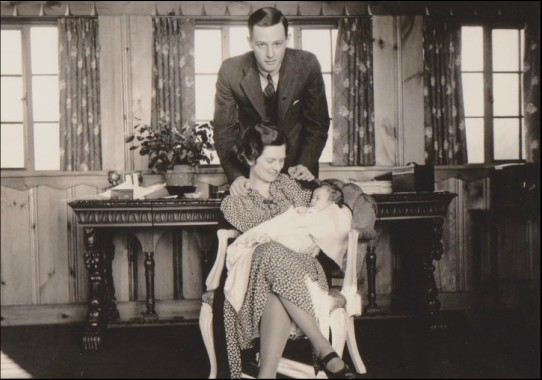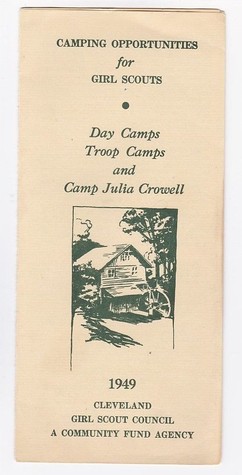Camp Crowell Hilaka Historic District (Richfield Heritage Preserve)
Introduction
Text-to-speech Audio
The Richfield Heritage Preserve is best known for the seventy-four years (1937-2011) it served as Camp Crowell Hilaka, a Girl Scout Camp operated by the Cleveland Girl Scout Council. Prior to becoming a Girl Scout camp, the 336-acre property was first settled by the Oviatt family. In the twentieth-century, half of the property was owned by James Kirby, a prolific inventor whose curious inventions can still be viewed on the property today. The Neals owned the other half of the property on which they grew apple and peach orchards and constructed fantastical houses. As a Girl Scout camp, Crowell-Hilaka hosted a variety of overnight camps that introduced girls of all backgrounds to nature and the values of the Girl Scouts. After the camp closed its doors in 2011, Richfield citizens approved a bond for the city to purchase the property and turn it into a nature preserve. Today, visitors can hike, fish, kayak, and more on the property from dawn to dusk year round.
Images
Girl Scouts in a ring beside Kirby Mill in 1959.
.jpg)
Friends of Crowell Hilaka Map, considered the most detailed map at present.
.jpg)
Girl Scouts tending to a campfire in 1942.
.jpg)
Campaign ad to fund the purchase of the Kirby property c.1936.
.jpg)
Advertisement in "The Vacuette Broadcaster" for the upcoming Vacuette Convention at the Kirby estate. The third annual convention was held soon after Garfield Hall was constructed in 1923.
.jpg)
The first structures the Neal family built on their new property were North House (pictured) and Coach House. Clarence and Clara Neal resided in this property. After the Neals sold the land, Girl Scouts used this structure for camping.
.jpg)
Herbert, Helen, and Barbara Neal in the living room of their newly constructed home, Amity House. After the Neals sold their land, Amity House became another camping site for Girl Scouts. Many photos from the Neal's time on the property are from Barbara Neal, the baby in this photograph.

A group of young girls in the "Brownie Nest" in 1942.
.jpg)
1949 brochure for Girl Scout camps available at Camp Julia Crowell.

Backstory and Context
Text-to-speech Audio
While the Richfield Heritage Preserve is best known for its time as a Girl Scouts camp, the property started off as a Western Reserve home for white settlers from the East Coast. In 1800, 25-year-old Herman Oviatt left Connecticut to claim his land in the Western Reserve, present-day Northeast Ohio. Initially, Herman settled in what is now Hudson, OH, with his wife and two children until he purchased the northwest quadrant of what would become Richfield Township. The Oviatts had an interesting collection of beliefs and practices. Herman believed education was a way to instill good morals and religious faith to create well-rounded citizens. He donated to Western Reserve College based on his beliefs and today there is an endowed professorship named after him at Case Western Reserve University. Herman’s wife, Eunice, was also an intelligent woman and she was known to befriend Native Americans in the area and even picked up three American Indian languages: Chippeway, Seneca, and Delaware. After Herman passed away in 1854, his son Nathaniel continued to run the property alongside his daughter, Ruth Freeman. The Oviatts were friendly with John Brown in nearby Akron and on occasion it is said that Oviatt family members would assist Brown’s smuggling of escaped slaves to Oberlin.
After nearly a century of owning their farm, the Oviatts parceled their property and sold half to James (Jim) B. Kirby and the other half to the Neal family. James Kirby was a prolific inventor with over 160 patents to his name. He is best known for his washing machine and vacuum cleaner called the Vacuette. When Kirby purchased the southern part of the Oviatt property in 1919, he began transforming the land based on his curious inventions. In 1920, Kirby constructed a house for his family that included air-conditioning using spring water and he built a dam with a water-powered millwheel that created the “lower lake”. Kirby named this lake Jinelle, a combination of his name and his wife, Nellie. Lake Jinelle is the only known body of water in the world that is patented because of its ability to eliminate sediment deposits to prolong the life of the lake. Among other modifications Kirby made to the property is Garfield Hall. Completed in 1923, Garfield Hall is built over industrial streetcar springs that cause the floor to bounce as guests dance on the wooden planks. During Kirby’s tenure, his property was a community space where area residents could visit on weekdays for recreational purposes or rent Garfield Hall for large events.
On the northern part of the property, the Neal family also left their mark in the form of magnificent houses. Clarence J. Neal was the owner of Neal Storage Company, a popular business throughout Ohio and other parts of the nation. Neal purchased the part of the Oviatt property that Ruth Oviatt Freeman and her husband had used for orchards. Accordingly, the Neals continued to grow peaches and apples and renamed the property the Neal Fruit Farm. In 1928, Clarence and Clara Neal constructed their first homes, North House and Coach House. The Tudor-style buildings buried deep in the forest provided a hideaway for the Neals. Then, in 1936, Hebert and Helen Neal joined the family with their new, larger home, Amity House.
As the Neals were building their third home on their portion of the property, James Kirby decided to sell his southern parcel of land. The Cleveland Girl Scout Council (CGSC) (now Girl Scouts of Northeast Ohio) saw Kirby’s land as the perfect spot for the first Girl Scouts camp in Cuyahoga County. After raising $60,000, CGSC purchased Kirby’s land in 1937 and named the property Camp Julia Crowell (CJC), after one of the members who was integral in purchasing the property. Over the course of the camp’s first 20 years, it was a popular spot for troop camping and even opened up to family camping in 1950. In 1943, CJC became one of the first camps in the U.S. to allow African American girls to stay overnight at camp. Building on the camp’s success, CGSC purchased the Neal’s 93-acres of land and annexed it to the existing Crowell camp. After a competition for names, CGSC chose the name Hilaka, a combination of “High Lake”, the name of the lake on the Neal’s property, and the sound “uh”. After 1960, the camp became known as Camp Crowell-Hilaka. For the rest of the twentieth-century, Camp Crowell-Hilaka offered day camping, overnight hikes, weekend camping, and summer camps that included horseback riding. In addition to many sites for tent camping, the Neal homes were used for “cabin” camping.
At the start of the twenty-first-century, Crowell-Hilaka experienced financial difficulties that led to the end of summer camps in 2000, the sale of the camp’s horses in 2005, and eventually the closing of the camp in 2011. After its closure, Crowell-Hilaka was at risk of being developed. However, in 2014, residents of Richfield Village and Township voted for a set of bonds to purchase the former camp under the ownership of the Richfield Joint Recreation District (RJRD). By 2016, the 336-acre-property had reopened as the Richfield Heritage Preserve. In the past decade, a group of former Girl Scouts and campers gathered to create the Friends of Crowell Hilaka (FoCH). Together FoCH works with RJRD to raise money to restore and preserve Crowell-Hilaka. On January 24, 2020, FoCH successfully got Camp Crowell-Hilaka Historic District added to the National Register of Historic Places. Today, the Richfield Heritage Preserve is open to the public from dawn to dusk for hiking, fishing, kayaking, and other daytime activities.
Sources
"Camp Crowell Hilaka Historic District." National Park Service. Accessed June 2, 2021. https://www.nps.gov/places/camp-crowell-hilaka-historic-district.htm
Cheetham, Jean Dick. "Hudson Centennial Celebration." Ohio Archaeological and Historical Quarterly 9 (1900): 368-371. http://books.google.com/books?id=w8Q1AAAAIAAJ&pg=PA368&lpg=PA368&dq=heman+Oviatt&source=bl&ots=HQoiAnv4jZ&sig=9EXPwr0bJ3RA_WgxQzZKB5MM1ic&hl=en&sa=X&ei=DIXpU5TMEcWwyAS9-oKADA&ved=0CC0Q6AEwBg#v=onepage&q=heman%20Oviatt&f=false
Friends of Crowell Hilaka for Richfield Heritage Preserve. Accessed June 2, 2021. https://www.friendsofcrowellhilaka.org/#/
"History." Richfield Heritage Preserve. Accessed June 2, 2021. https://www.richfieldheritagepreserve.com/history.html
https://www.friendsofcrowellhilaka.org/cleveland-press-archives.html#/
https://www.friendsofcrowellhilaka.org/map.html#/
https://www.friendsofcrowellhilaka.org/cleveland-press-archives.html#/
https://www.friendsofcrowellhilaka.org/buying-the-kirby-estate.html#/
https://www.friendsofcrowellhilaka.org/garfield-hall.html#/
https://www.friendsofcrowellhilaka.org/neal-architecture.html#/
https://www.friendsofcrowellhilaka.org/neal-family-history.html#/
https://www.friendsofcrowellhilaka.org/cleveland-press-archives.html#/
https://www.friendsofcrowellhilaka.org/girl-scouts-at-camp-1940s.html#/
